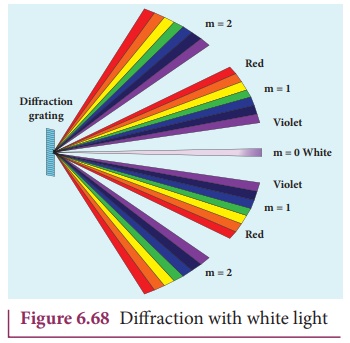Diffraction - Determination of wavelength of different colours | 12th Physics : UNIT 7 : Wave Optics
Chapter: 12th Physics : UNIT 7 : Wave Optics
Determination of wavelength of different colours
Determination of wavelength of different colours
When white light is used, the diffraction pattern consists of a white central maximum and on both sides continuous coloured diffraction patters are formed. The central maximum is white as all the colours meet here constructively with no path difference. As θ increases, the path difference, (a+b)sinθ, passes through condition for maxima of diffraction of different orders for all colours from violet to red. It produces a spectrum of diffraction pattern from violet to red on either side of central maximum as shown in Figure 6.68. By measuring the angle at which these colours appear for various orders of diffraction, the wavelength of different colours could be calculated using the formula,

Here, N is the number of rulings per metre in the grating and m is the order of the diffraction image.

Related Topics